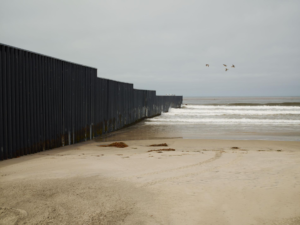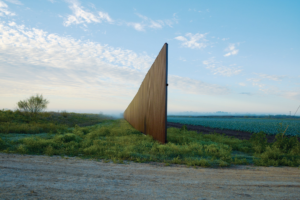The Wall, the Fence, the Desert
In 1914 America’s poet Robert Frost wrote a poem, Mending Wall, made famous by its opening line:
The book Why Walls Won’t Work: Repairing the US-Mexico Divide, Michael Dear noted that “The 1996 Illegal Immigration Reform and Immigrant Responsibility Act provided broad authorization to construct barriers along the international boundary, and the Secure Fench Act of 2006 specified the construction of 850 miles of additional fencing. The Mexican government resolutely and repeatedly opposed the fortifications, saying on one occasion: ‘a wall is never the solution to problems,’ and that ‘all walls eventually get torn down.'” It is at this point in time when the flood of migrants from Mexico into America began, during the Clinton administration’s hard and ultimately futile line against the highly lucrative traffic in drugs and the coincidental disruption of traditional trade patterns. Under the Bush administration, the Secure Fence Act of 2006 was passed, adding to the Clinton fence and to the already massive buildup of borderland security. The fencing costs about $4 million a mile at the low end and, at the high end, $12 miiion a mile. In the 2012 book, Continental Divide: Wildlife, People, and the Border Wall, Krista Schlyer made the connection between the harm done by a barrier wall during a time of global warming. “The wall now covers only about one-third of the length of the border, undercutting the ecological integrity of the borderlands, not fully severing it.” She asked, “..what is the impact of the sudden arrival of a great wall within a desert that is experiencing rapid warming and prolonged drought conditions? Though we look at nature in pieces, a landscape is really a whole being, with individual components working together, each playing its part. A wall through an eco-system can act as a tourniquet, severing, slicing, and constricting vital dynamics. We know that the wall may cause serious, lasting harm to the biodiversity of the region..”
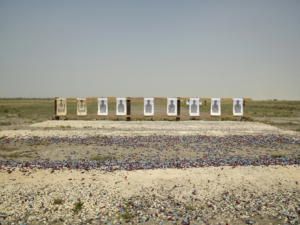
The red and blue objects on the ground are spent shotgun shells. This image was taken quickly with a cell phone
Border Patrol target range. Boca Chica Highway, near Gulf of Mexico, Texas (2013)
However, building walls have been a feature of the late twentieth century. By the time the Berlin Wall came down, there were fifteen border walls; and today, post-September 11, there are 77 walls worldwide. Elisabeth Vallet, a geography professor at the University of Quebec-Montreal stated, Elisabeth Vallet, a geography professor at the University of Quebec-Montreal. “Walls are public relations exercises where governments demonstrate that they are actually doing something..They usually create more problems.” For example, there is a 2500 mile border wall between India and Bangladesh, far exceeding anything existing on America’s southern border. India has also built a 450-mile barrier against Pakistan. One of the most egregious is the 2002 wall, four hundred miles, runs along the West Bank, dividing Israel from Palestine. There is a mile long wall at Calais in France to keep migrants using the Channel Tunnel to enter Europe. These walls are lesser known to Americans who are focused on their own Wall. In the early twenty-first century, the term “The Wall” refers not to the Berlin Wall but to the Border Wall built by a government to shut off a nation–Mexico–that it is not at war with. It is often forgotten that until 1845, the American southwest was Mexico and the inhabitants traveled north and south freely. Trade was the main reason for travel between central and North America, but the climate was another motivator. The native Americans would spend the winter in the south and in the summer, they would go north, as far as modern Colorado. The Wall along the Mexican border has disrupted patterns of travel that are literally hundreds of years old.
As a photographer of the desert, Richard Misrach would have inevitably and constantly come up against this barrier, impeding his journey. The Wall became part of his long poem, The Desert Cantos, which is divided into numerous sections, including, The Terrain, The Event, The Flood, The Fires, The War (Bravo 20), The Pit, Desert Seas, The Event II, Project W-47 (The Secret), The Test Site, The Playboys, Clouds, The Inhabitants, and The Visitors. The Desert Cantos, inspired by Ezra Pound’s fifty-year project, will eventually number beyond forty, with each segment being able to exist on its own but is also a part of a larger whole. As Misrach explained in an interview with John Paul Caponigro, “Any given single Canto has no bearing whatsoever without the rest of the Cantos. That’s clearly why I structured it that way from the beginning. It’s the same as an image, you take one image and as soon as you start pairing it with other images it takes on much bigger meaning. We’ve all been doing that. What I’m trying to do is take each of the Cantos and do the same thing by building on it with other Cantos..In the history of photography, there’s a literary model which has been used over and over again, which is the photographic essay. It’s basically a literary model from Robert Frank and Walker Evans. The model that I’m trying to build on is the epic model in literature which is something that is accumulating over time.”
It is no accident that the Border Wall is built in the desert and mostly on lands or properties that the government deems to be uninhabited or inhabited by those easily pushed aside. Such a structure could never be built over valuable farmland or cattle grazing land for example, and those who own ranches on or near or threatened by the Wall fight its presence or any attempt to erect a new stretch on owned land. It is safe to say that the government has scant interest in the desert as an environment in its own right. For those opposed to migration, the desert is a natural deterrent to those who must cross its deadly heat. But there are people like the photographer who appreciate the open skies and the bright lights. As Misrach said, “The light, the space, the solitude, the silence. Oh my god. It’s a really powerful place to be. You’re with yourself. But the problem is because people characterize the desert as a wasteland that’s why military corporations like to dump their toxins out there because they consider a place like Nevada a ‘national sacrifice area.’ Because it’s a waste land. It’s ugly. It’s barren. And yet it is a remarkable place.” In discussing the oeuvre of Misrach, the critic Philip Gefter wrote in 2006 for The New York Times: “One criticism often leveled against Mr. Misrach’s work is that it aestheticizes disaster. To such criticisms, he has responded that if he were to make ugly photographs of bomb testing sites, no one would consider the land worth preserving. By delivering the bad news with visual finesse, he suggests, there is potential for greater scrutiny. “Shakespeare uses profoundly rich and gorgeous language to convey the most terrible and tragic elements of the human condition,” Mr. Misrach said. ‘It’s the way the story is told that makes us re-examine life afresh.'”
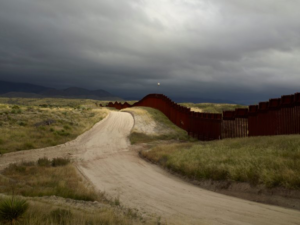
The Border Cantos, released in 2016, is his most recent work to date. His gallery, the Fraenkel Gallery stated, the “Border Cantos expands on years of prior work, covering the entire length of the Mexican-American border, all 1969 miles, Pacific to the Gulf of Mexico. He shows us the existing walls that bisect cabbage fields and communities, slice through individual backyards, extend mile after mile through desert and end in the Pacific Ocean. They are a hodgepodge: squat cement barriers, intimidating-towering steel divides, wire mesh, WW II Normandy-style fencing to prevent vehicles but not people. We also see the ‘digital walls’ (8000 or so cameras, 11,000 underground sensors, etc.) the ones that work.” This project was begun by Misrach in 2004 and he began to collaborate with the Mexican composer Guillermo Galindo, by sending him the discards he picked up in the desert. Galindo, in his turn, made musical instruments out of the detritus and composed music for the object to play. The composer said, “I saw the landscape as a big orchestra. The sound that every object produces is attached to its existence in the world.” Misrach became aware of this project in 2012 and began participating, sending the composer the objects he found lying in the desert, each mutely telling a life story of a long journey.
Misrach has been wandering the terrain bisected by the wall for years, ceaselessly maneuvering back and forth. He explained in the article “Surreal Photos Show Walls Dividing U.S. and Mexico:” “In 2009—as I became aware of an increase in the building of walls and surveillance towers and other government activities along the 1,954-mile-long U.S. border with Mexico—I began photographing in earnest..For this project, I’d usually fly to a city and rent a four-by-four so I could explore the more remote regions of the border. Sometimes I’d set off a ground sensor, which brought out U.S. Border Patrol agents. Some were terrific—one even came out to protect me because she was worried that cartel activity was nearby—but others could be hostile.” The Cantos show that there is no “wall” in the sense of a continuous structure that seals a territory from impenetrable end to end. Such constructions that seal a territory from one end to the other are rare. The line of trenches that ran to the North Sea during the Great War comes to mind and even that zone had an end: Switzerland. The Border Wall moves in fits and starts, beginning here and ending there, bits and pieces that may or may not match their counterparts, each segment ultimately stands alone and isolated. The problem of discontinuity is one of the difficult terrain, the hostility of the desert itself to intruders, the intervention of a long river, and the objections of landowners who have a propensity for lawsuits and fight eminent domain. Thus the concept of the “Wall” is an absurdity in the concrete sense–such an entity can never be built along this particular border. In no-persons’ land, the war zone on the Mexican side of the border is littered with dead bodies, discarded water bottles, tire tracks of trucks long passed, and signs of the ingenuity of those on foot who attempt to bypass the Border Patrol. Misrach said, “Basically people have walked a long way from Central America and Mexico, and their clothes are filthy, and they often dump them after they’re across the border because they bring fresh clothes with them. Also, the Border Patrol has been known to make people dump whatever they have when they find them. You see backpacks and tennis shoes, religious icons and Bibles, and all kinds of things strewn along the border.”
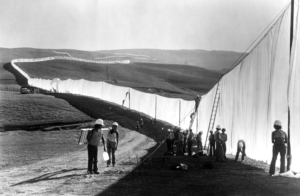
Christo and Jeanne-Claude
Running Fence, Sonoma and Marin Counties, California, 1972-76
The band of iron that undulated through the rolling terrain of the desert is an echo of Christo’s Running Fence of 1973. Even that temporary ribbon of fabric aroused anger and resistance from the residents of northern California. The Fence lasted a short time, thwarting birds and animals and humans, living on as a documented experience and as an art installation. And then, as with all Christo experiments, the Running Fench disappeared and the hills were open once again. As Robert Frost said, it is human nature to want to defy a Wall.

